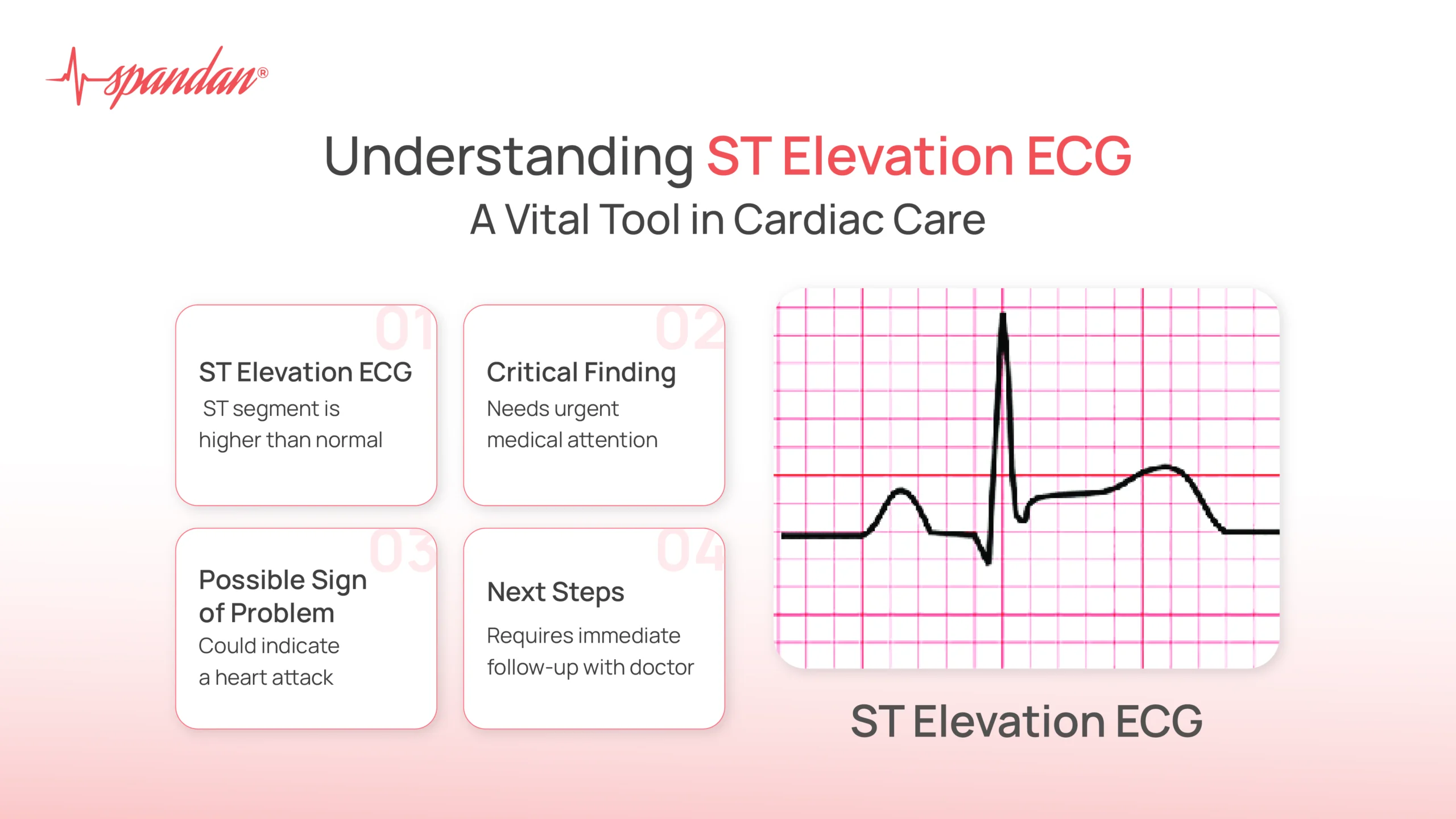
Related Article
Author:- Mr. Ritesh Sharma
In the domain of cardiology, the electrocardiogram (ECG) stands as an indispensable tool for diagnosing and monitoring heart conditions. Among the various patterns observed in an ECG, the ST elevation is of paramount importance.
This article delves into the intricacies of ST elevation ECG, exploring its causes, diagnostic value, and implications for patient care. When an ECG shows an ST elevation, it often signals acute myocardial infarction (AMI) or a heart attack, necessitating immediate medical intervention.
The ST segment represents the period when the ventricles are depolarized, and its elevation suggests a portion of the heart muscle is experiencing a lack of blood flow and oxygen. Understanding the nuances of ST elevation ECG is crucial for healthcare professionals and patients alike, as timely identification and treatment can be life-saving.
By the end of this article, readers will have a comprehensive understanding of the significance of ST elevation ECG in cardiac care, including its role in diagnosis, management, and prognosis of various heart conditions.
What is ST Elevation ECG?
An ST elevation ECG is characterized by an upward deviation of the ST segment from the baseline in at least two contiguous leads. This pattern often signals acute myocardial infarction (AMI) or heart attack, a condition requiring immediate medical intervention. The ST segment represents the period when the ventricles are depolarized, and its elevation suggests that a portion of the heart muscle is experiencing a lack of blood flow and oxygen.
Causes of ST Elevation
Several conditions can lead to an ST elevation ECG, with the most common being acute myocardial infarction. Other potential causes include:
- Pericarditis: Inflammation of the pericardium, the sac surrounding the heart, can cause diffuse ST elevation.
- Early Repolarization: A benign condition often seen in young, healthy individuals, characterized by a slight elevation of the ST segment.
- Left Ventricular Aneurysm: A complication of a previous myocardial infarction, resulting in a persistent ST elevation.
- Hyperkalemia: Elevated potassium levels in the blood can cause changes in the ECG, including ST elevation.
- Brugada Syndrome: A genetic disorder that can cause ST elevation in the right precordial leads and is associated with an increased risk of sudden cardiac death.
Diagnostic Importance of ST Elevation ECG
The identification of ST elevation on an ECG is crucial for the prompt diagnosis and treatment of acute myocardial infarction. Rapid recognition allows for timely interventions such as thrombolysis or percutaneous coronary intervention (PCI), which can restore blood flow to the affected area of the heart and minimize damage.
An ST elevation ECG is also valuable in differentiating between various cardiac and non-cardiac conditions that can present with chest pain. For instance, while both pericarditis and myocardial infarction can cause chest pain and ST elevation, the pattern and distribution of the elevation differ, guiding appropriate management strategies.
Management and Treatment
When an ST elevation ECG indicates an acute myocardial infarction, immediate treatment is essential. The primary goal is to restore blood flow to the heart muscle, which can be achieved through:
- Thrombolytic Therapy: The administration of clot-dissolving medications to reopen blocked arteries.
- Percutaneous Coronary Intervention (PCI): A procedure that involves the insertion of a catheter to place a stent and open up the narrowed or blocked coronary artery.
- Coronary Artery Bypass Grafting (CABG): A surgical option for severe cases where multiple coronary arteries are blocked.
In cases where the ST elevation is due to non-ischemic causes, treatment focuses on addressing the underlying condition. For example, pericarditis may be managed with anti-inflammatory medications, while hyperkalemia requires correction of the potassium imbalance.
Prognosis and Outcomes
The prognosis for patients with an ST elevation ECG largely depends on the cause and the timeliness of treatment. Acute myocardial infarction, if treated promptly, has a significantly better outcome compared to untreated cases. The mortality rate decreases substantially with early intervention, highlighting the importance of rapid diagnosis and management.
Non-ischemic causes of ST elevation generally have a more favorable prognosis, especially conditions like early repolarization and pericarditis, which are often benign and self-limiting. However, conditions like Brugada syndrome require ongoing monitoring and may necessitate the implantation of a cardioverter-defibrillator (ICD) to prevent sudden cardiac death.
Advances in Technology
Technological advancements have significantly enhanced the accuracy and efficiency of diagnosing and managing conditions associated with ST elevation ECG. Portable ECG devices, such as the Spandan ECG, have revolutionized cardiac care by providing quick and accurate readings, even in remote or resource-limited settings. These devices enable real-time monitoring and immediate sharing of ECG results with healthcare providers, facilitating prompt decision-making and intervention.
Moreover, innovations in telemedicine and mobile health applications allow for continuous monitoring of patients with known cardiac conditions, ensuring that any changes in their ECG patterns are promptly detected and addressed. This proactive approach can significantly improve patient outcomes and reduce the burden on healthcare systems.
The ST elevation ECG remains a cornerstone in the diagnosis and management of various cardiac conditions, particularly acute myocardial infarction. Its significance cannot be overstated, as timely identification and intervention can be life-saving. Understanding the nuances of ST elevation, its causes, and appropriate management strategies is essential for healthcare professionals and patients alike.
As technology continues to evolve, the integration of advanced ECG devices and telemedicine solutions promises to further enhance the accuracy and efficiency of cardiac care. By leveraging these innovations, we can ensure that patients receive the best possible care, regardless of their location or access to healthcare facilities.
In conclusion, an ST elevation ECG is more than just a pattern on a graph; it is a critical indicator of underlying cardiac issues that require immediate attention. By recognizing and understanding this vital diagnostic tool, we can improve patient outcomes and save lives, reaffirming the importance of ECGs in modern medicine.




